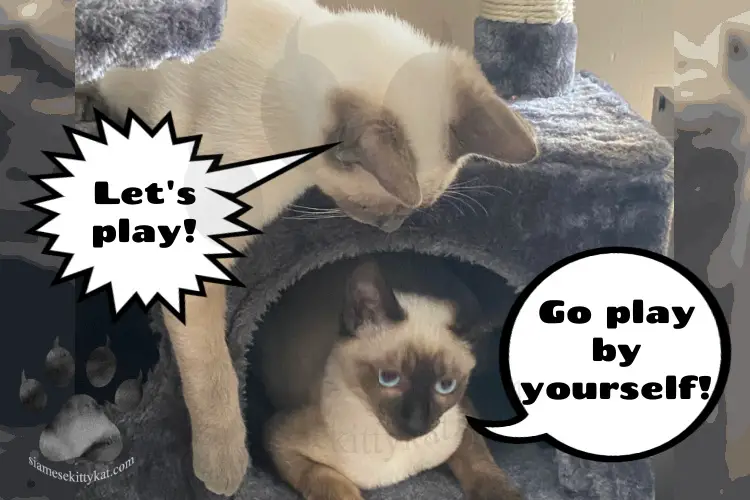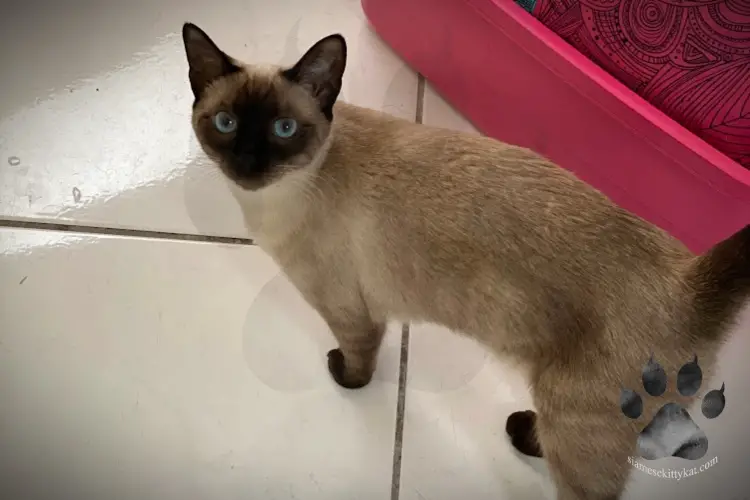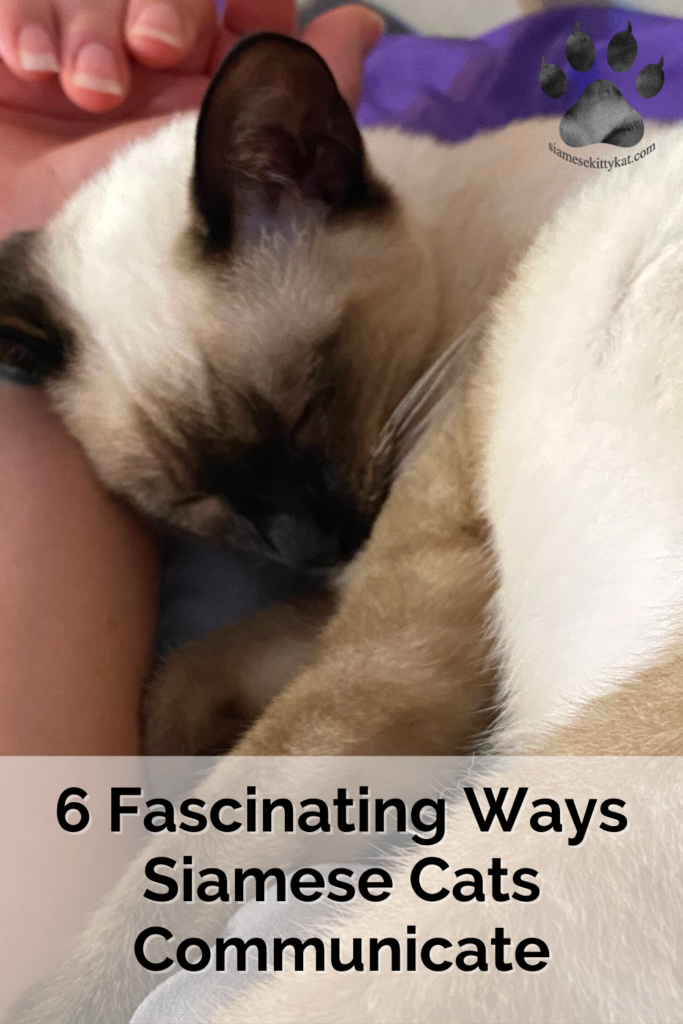Siamese cats are one of the most interesting breeds of felines you’ll ever meet. Not only are they super intelligent, loving, and playful, they also have very fascinating ways in which they communicate, both with their fellow felines and with their human parents.
I have owned Siamese cats for quite a number of years, and they still continue to surprise me with their quirky personalities and unique ways. If you already have one of these pretty kitties at home, you’ll know their loud and somewhat strange voice is not their only way of communication.
In this article, I’ll share with you all the ways in which your Siamese communicates, as well as how to read a cat’s meow and what to do when your Siamese is meowing too much. Let’s get into it!
How do Siamese cats communicate?
While we may feel like we know our Siamese kitties better than anyone, cats are known for being hard to read. Unless it’s mealtime and they’re meowing for their next feed, it can be difficult to pinpoint what exactly your Siamese is trying to tell you.
Believe it or not, Siamese cats understand you far more than you understand them. These clever cats are more intelligent than your average breed and will spend hours upon hours observing you and your everyday routine.
That being said, it is possible for us to understand our furry companions better. We just have to take a page out of their book and spend a bit more time observing them. You’ll soon see that Siamese cats communicate with you in more ways than 1!
1. Meowing
Have you ever heard your Siamese meowing at another cat the same way they meow at you? I know I haven’t!
This is because meowing is a method designed specifically for us humans to understand. There is no universal cat language that involves meowing to chat.
These clever little kitties have learned that the best way to communicate with humans is through meowing, and they have even come up with various meows to communicate different things. Your Siamese also knows what you specifically understand and interpret; therefore, no cat meow is the same.
That is why you’re pretty much on your own when it comes to understanding what your Siamese is trying to say.
2. Purring
If you ask what purring means, most people will tell you this means your cat is relaxed and content. While this is true in most cases, it’s better to interpret these cute vibrations as “please don’t leave” or “keep doing what you’re doing.”
While most of the time, your Siamese will be purring because they’re happy and you’re petting them, purring can also mean that they are scared, injured, or sick. This is when the “please don’t leave” would come into play, as they’re telling you to stick around and care for them.
3. Blinking
Ever seen your Siamese looking at you with long, slow blinks? This means that they’re completely comfortable with you!
Kitties will also communicate this way with other felines, showing that they trust them. Siamese cats will also use this gesture with their humans to tell them that they accept and trust their owners.
Try slow blinking at your Siamese if you want to reciprocate this feeling.
4. Rubbing and Headbutting
I would understand if you thought your Siamese was headbutting you to start a fight, but it’s actually quite the opposite! Siamese kitties will rub against you as a way of showing that they love you.
Along with essentially marking you as their territory, Siamese cats will also weave in and out of your legs as a way of saying “I missed you” or “I’m glad to see you.”
Funnily enough, feral felines will also do this with fellow kitties, especially if they’ve been separated for some time. It is simply their way of hugging you and sharing the love.
5. Tail Posture
You can learn so much about Siamese cats through their body language and tail posture. In fact, I wrote an entire article about it! They communicate fluently through their bodies, just like dogs do with their tails.
For example, if your Siamese’s tail points to the sky and their fur is relaxed, this indicates that they are happy and confident. On the other hand, if their tail is in the exact same position, but their fur is spiky like a hedgehog, they’re feeling angry or scared.
If your Siamese is thrashing their tail left to right, chances are they are irritated, and you should leave them alone. If their tail is tucked, they may feel insecure or anxious.
Siamese cats rely heavily on their body language to communicate, so I suggest you learn more about this to understand your kitty fully. Plus, it’s just super interesting to know!
6. Arched Back
While there are many postures to learn about, perhaps one of the most important ones is the arching of the back. The tail will be high, and the hairs on your cat’s back will be standing up.
This is your Siamese’s way of telling everyone (including you) to back off. As much as we’d like to comfort our kitties during this, it is better just to leave them alone and let them relax.
Do Siamese cats talk to each other?

As I mentioned earlier, cats only use meowing to communicate with humans and not their fellow felines. Communication feline to feline is actually rather complicated, since not only do they share via vocalizations, but through physical contact, chemical cues, and visual cues.
When it comes to cats talking to each other, it tends to involve a range of purrs, murmurs, hisses, growls, and howls. Feral cats tend to be quiet, with the occasional purr or hiss.
Domestic cats are pretty vocal with one another, using a range of murmurs, meowing (different from how they communicate with us humans), and growls.
If you find your Siamese hissing or whaling loudly at another feline, they are expressing fear and anxiety. A low growl is usually a warning, especially when hissing is also involved.
Why do Siamese cats meow a lot?
When I first met my very own Siamese, I was rather shocked to find out just how much they meow. Morning, afternoon, evening, and night; there wasn’t a time in which my house wasn’t accompanied by meowing!
Now that I have two Siamese cats at home, Batman and Robyn, it’s even noisier since they spend a good amount of their time talking to one another. That being said, it warms my heart to see them getting along so well. Plus, I know that they’ll always have someone to talk to!
Here are the two main reasons why your Siamese cat meows so much:
- They’re sociable creatures
It’s as simple as that! Siamese cats love love love to be a part of the family. That includes getting in on conversations, watching tv with their humans, and my favorite, sitting on the edge of the bathtub while I unwind after a long day.
You won’t be surprised to know that many Siamese owners feel like they have a dog in their house instead of a cat, mainly because they’re always trying to be up in everyone’s business.
These pretty kitties make lovely pets for lonely people or those who have children since they’re kind, talkative, and playful. They’ll always be up for a conversation and be ready to listen after a long day.
- They hate being ignored
While Siamese kitties are loving, they’re also very demanding. This means you can’t ignore them even for a day, or they’ll be hell to pay.
Siamese cats tend to get very loud and sometimes destructive when they’re feeling neglected. This is because they know that scratching up your favorite couch or screaming the house down is a sure way to get their humans attention.
Siamese cats can actually develop anxiety and depression when left alone too long. Hence, I always say, never get a Siamese unless you have enough time, love, and attention to dedicate to them.
What is my Siamese trying to say?

You may have noticed your Siamese making a range of noises. They’re actually referred to as “meezers” due to the strange baby-like sounds they make.
These clever little kitties have come up with various ways to communicate different things to their parents, resulting in getting other things or being treated a different way.
If your Siamese is yowling at you, this could mean that they’re uncomfortable with their surroundings, or they’re hurt and in pain. They would also simply be bored and looking for entertainment. That is why it is essential to watch for physical signs to figure out why your Siamese is yowling.
How to stop your Siamese cat meowing so much
While these sounds can certainly be endearing and often welcomed, there are times when one does wish that the Siamese was a little quieter (especially when we’re trying to sleep!)
If you’re looking for ways to help your Siamese quieten down, have a look at these tried and tested (by yours truly) hacks.
1. Play with your Siamese before bed
Siamese cats are packed full to the brim with energy. If you don’t have enough time to play with them, you’ll soon know about it. Meowing due to boredom usually worsens at night since their human is sleeping, so they also feel alone.
To counter this, dedicate at least 45 minutes before bed to playing. This should include high-energy exercises such as chasing toys and playing with toy fishing rods.
This should be followed by 15 minutes of calming activity, such as cuddling or socializing. This will get your Siamese nice and tired, so they will hopefully sleep through most of the night.
If you find that your Siamese is still up and about while you’re sleeping, try giving them something to do, such as a cat puzzle. You can also hide treats and toys around the house so they can have a little treasure hunt as you sleep.
2. Set up a cat bed
Siamese cats love sleeping with their owners, but not all owners like sleeping with their cats. Whether that’s due to allergies, your kitties taking up too much space, or simply wanting some time alone; it is your job to ensure that your Siamese also has a comfortable and warm place to sleep.
Cat’s enjoy sleeping on high shelves as they can still see the surroundings but have their own space. They’ll even be happy if you give them a box with a blanket – basically, anywhere they can snuggle down and feel safe for the night.
It’ll be best if you let them see you while you’re sleeping, as they will feel less lonely and safer if their human is in their sight.
3. Feed them on a schedule
If your Siamese has a flimsy food routine, they’ll likely meow every time they are hungry. This sends a message to you that they want feeding, and they’ll begin excessively meowing until they get what they want.
Feeding your Siamese at the same time every day will let them know that they don’t need to meow for food, as it will always be there at a particular time.
Do not respond to begging. If your Siamese begins meowing, move to another room. Once they have stopped, you can then go and fill their bowl.
Cats tend to wake up their owners for breakfast. If your Siamese wakes you up for food, wait at least 15 minutes before you feed them.
4. Consider another cat
Siamese kitties thrive in pairs. Having a fellow feline in the house means they always have someone to play with, and they always have company when the humans aren’t around.
Having more than one cat can sound like more work, but honestly, I found having two Siamese instead of one far less hassle. They always have each other to lean on, and they became far less clingy once they were together.
Of course, if you don’t want to get another Siamese, you’ll have to find a breed that can keep up. You don’t want to get a senior kitty who hates playing, as your Siamese will just ignore them. It would be better to get another high-energy feline that enjoys being just as sociable as your Siamese.
How do Siamese cats show affection?
So we know that Siamese cats purr, meow, and rub around our ankles as a sign of affection, but is there anything else?
There are actually a ton of ways these kitties will proclaim their love to their owners! Here are just a few:
How you can show your Siamese love
It’s pretty simple, really; show your kitty enough time, attention, and affection, and they’ll love you forever. Take at least 30 minutes to play with your Siamese out of your day. Ensure them that they feel loved by chatting to them and letting them sit next to you.
Siamese cats simply want to feel like part of the family.
Don’t lock them out of the living room or shoo them away when you’re trying to work. Instead, give them a place to rest where they can watch you from afar. Most of the time, they won’t even bother you, and they simply want to be in your company.
Praise your Siamese when they do something good. Give them plenty of treats and lots of cuddles. Basically, treat them as you would your own human child, and they’ll love you for eternity.
How do you tell if a Siamese cat loves you?
While Siamese cats are friendly creatures, they can be finicky with who they decide to like.
If a Siamese cat loves you, it’ll be pretty easy to tell. They’ll want to spend time with you, ask for cuddles, chat to you endlessly, follow you around the house, and want to play with you constantly.
That being said, remember that all cats are different. Even the Siamese, known for their sociable ways, are sometimes standoffish due to past events or simply due to their personalities. If your Siamese doesn’t want to sit on your knee or isn’t very vocal, don’t think that they don’t love you; they may just have other ways in which they show their affection!
Want to learn more about your Siamese cat’s behavior? We have compiled every information you need to navigate through the fascinating world of Siamese cats: Everything About a Siamese Cat’s Behavior: A Comprehensive Guide
Get your FREE Siamese Cat 2024 Printable Calendar


